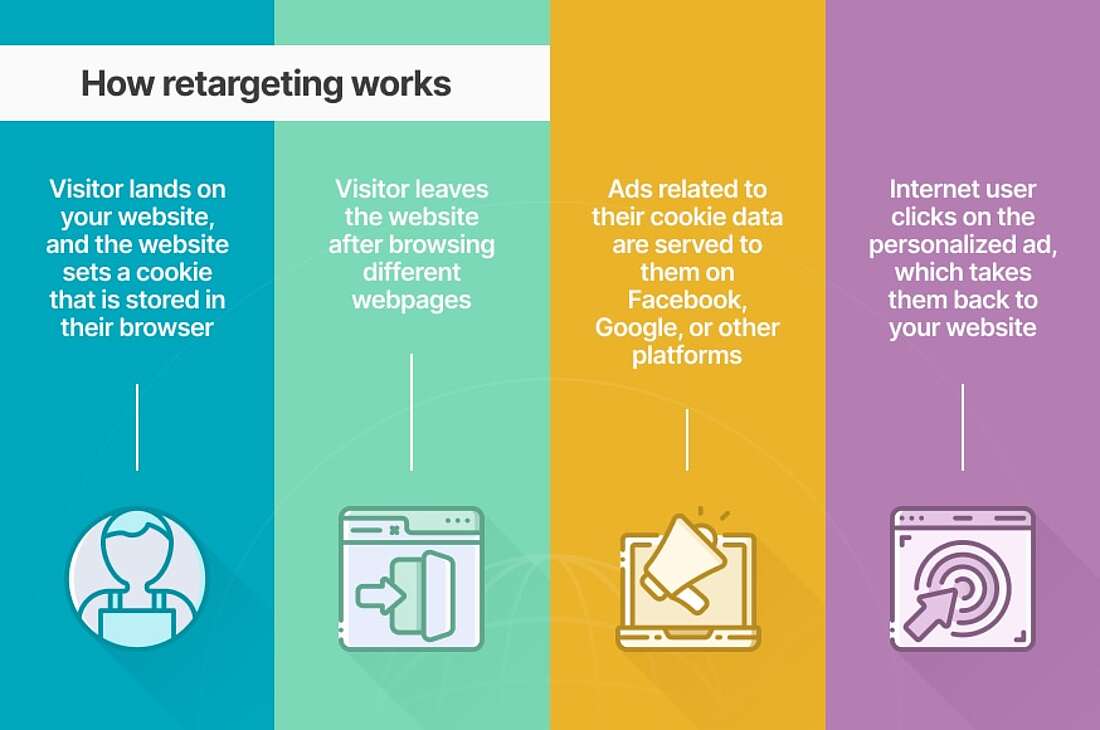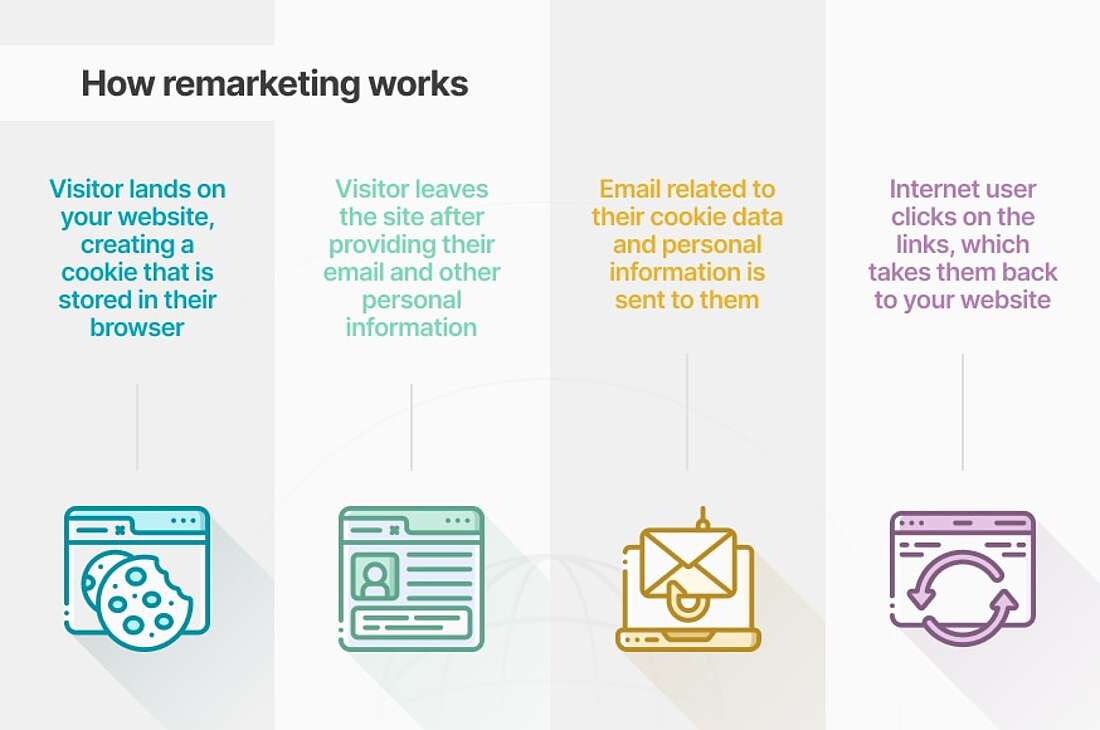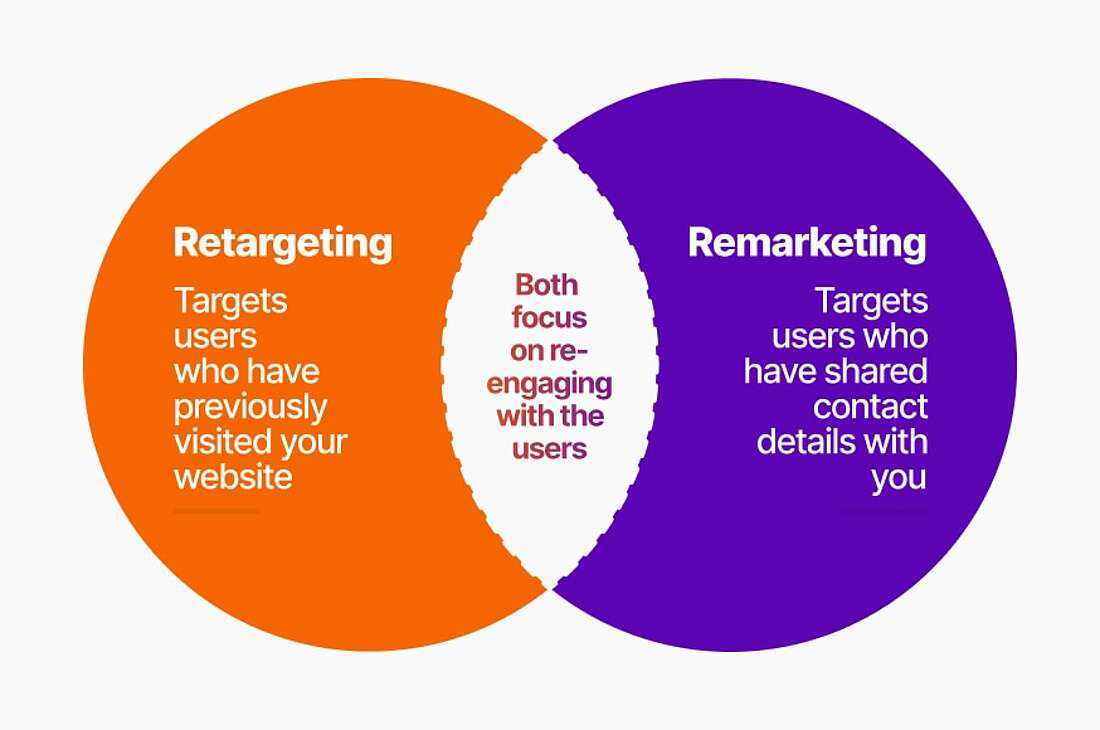- Why Us?
- Features
White Label
For SaaS Platforms & Agencies
Provide our complete analytics suite to your clients, directly within your own interface and with your/their own branding. Discover Analytics-as-a-Service and White Label Analytics. Great benefit, minimal effort.
- Pricing
- White Label
- Success Stories
- ResourcesGetting Started
CONTENTS
- Snapshot Summary
- What Is Retargeting?
- What Is Remarketing?
- Retargeting vs. Remarketing Difference
- Quick Examples of Retargeting and Remarketing
- Real-World Retargeting Example
- Real-World Remarketing Example
- When to Choose Retargeting vs. Remarketing
- Retargeting: For Websites with High Traffic Looking for Immediate Conversions
- Remarketing: Customer Re-Engagement and Long-Term Relationship Building
- Retargeting and Remarketing on Different Platforms
- Retargeting vs. Remarketing on Google Ads
- Retargeting vs. Remarketing on Facebook
- Retargeting vs. Remarketing on Other Channels
Retargeting vs. Remarketing: What's The Difference?
Learn About Two Ways to Rekindle Interest from Past Website Visitors

Did you know that nearly 80% of consumers say they only interact with offers that reflect their previous interactions with a business?
This striking figure from a global poll conducted by Marketo highlights that most internet users actually prefer retargeting and remarketing strategies.
They’re highly effective routes to conversion that maximize personalization based on available data, and allow businesses to focus on people who have already shown an interest in them.
In this blog, you’ll discover what these approaches entail. You’ll also learn the difference between remarketing and retargeting, the best use cases for each, and how they function on popular digital channels like Facebook and Google Ads.
Snapshot Summary
Retargeting | Remarketing | |
Purpose | Both strategies aim to re-engage with website visitors after they have interacted with your website. | |
Primary Channel | Ads | |
Target Audience | Anonymous visitors who haven’t converted. | Known visitors who have freely provided their email addresses. |
Common Use Case | Displaying ads across other websites, channels, and search platforms to remind visitors of what they viewed on your site. | Sending personalized emails to remind visitors of abandoned carts, promote new offers, or provide recommendations. |
Example Platform | Ad platforms like Facebook Ads, Instagram Ads, LinkedIn Ads, Google Display Network, AdRoll, and Criteo. | Email platforms like Listmonk, ActiveCampaign, Mailchimp, HubSpot, Constant Contact, or the in-house CRM system. |
Personalization | Tailored to historic browsing data, such as the webpages, products or services they viewed, the content of abandoned carts, etc. | Tailored to website browsing data and provided email address, as well as any other personal information collected. |
Privacy Implications | Relies on tracking pixels and cookies*, which creates compliance work and requires consent under privacy laws. | Requires consent management for using personal data, as well as explicit permission to email them for the stated intention. |
* Advancements in privacy-compliant tracking technologies means that
it's now possible to track cookieless without losing visitor data.
What Is Retargeting?
In an ideal world, every website visitor would turn into a customer.
Unfortunately this never happens.
Many people leave without buying something, signing up to anything, or providing their contact details.
But that doesn’t mean that they’re not interested in what you sell or won’t buy from you in the future.
This is where retargeting strategies come in.
Retargeting delivers ads for your business that follow visitors as they continue their journeys through the internet.
Common retargeting ad examples include banner ads, social media ads, or even display ads on third-party websites.
Each of these are tailored to remind users of the products or services they viewed.
It can also be done on Google by attempting to attract internet users to your site based on past search behavior that is related to your industry. This is known as search retargeting or SEO remarketing, a confusion of terminology that we'll cover in more detail later in this article. Crucially, paid ads can actually influence organic SEO results - meaning that retargeting can help other areas of digital marketing.
For now, it’s important to remember that retargeting marketing attempts to get anonymous people who didn’t convert to come back to your website.
And since they’ve already shown an interest in you, they’re the type of internet users that you want to be focusing on.
It’s a highly effective approach.
On average, 26% of retargeted visitors will return to your site, and they’re 70% more likely to convert (Invesp).
What Is Remarketing?
Remarketing is also about encouraging internet users to return to your website.
It specifically targets individuals who have shown a real interest in your business.
These are visitors who have provided their email addresses, but they might also have created an account, bought something, or signed up for a service.
Remarketing is done by email.
This allows for real personalization since:
→ they’ve explicitly provided you with their contact information and,
→ you should also be able build the emails around data on what they’ve done on your site.
And because of this, email remarketing is a highly persuasive form of motivation - it's also now particularly easy to do thanks to email automation.
In fact, about 60% make a purchase online after receiving a remarketing email (Constant Contact).
Retargeting vs. Remarketing Difference
Retargeting and remarketing are two related concepts with key differences that are important to understand. Both aim to reel former visitors back to your website.
The differences come down to the amount of information you have about them and the channels used to reach them.
Retargeting uses ads that appear on social media, search platforms, and other sites. It targets people who left your site without making a purchase or providing contact details. As a result, ads can only be personalized around page views, the contents of abandoned carts, and other behavioral data that you can collect with a web intelligence platform like TWIPLA.
In contrast, remarketing is conducted via email. It targets individuals who didn't make a purchase but did provide their contact details and consent to be contacted. This allows for much deeper personalization in emails, using personally identifiable information along with data on the pages or products they viewed and the contents of their abandoned carts.
Confusing Usage of Terminology
It’s also important to note that some platforms use the terms retargeting and remarketing to mean different things:
- Google Ads: Often refers to retargeting efforts as "remarketing." While it primarily uses cookies to track user behavior across the web, it also allows advertisers to use email lists for targeted ads, blurring the line between the two terms.
- Facebook: Uses the term "remarketing" for its Custom Audiences feature, which targets internet users based on uploaded contact lists. At the same time, it refers to behavior-based ads as retargeting. This dual terminology can lead to confusion.
- LinkedIn Ads: Uses the term "matched audiences" to describe retargeting efforts based on user behavior, while it also allows for uploading email lists to create custom audiences for targeted campaigns, similarly mixing the terms.
- Microsoft Advertising: Microsoft refers to its retargeting efforts as "remarketing." It focuses on targeting internet users based on their previous interactions with ads and the site, but the distinction can be lost when discussing email-based marketing.
- AdRoll: This platform often blends the terms as well, using "remarketing" to encompass both behavior-driven ads and email-driven campaigns, leading to potential misunderstandings in its documentation and communications.
Quick Examples of Retargeting and Remarketing
Understanding how retargeting and remarketing work in practice can further clarify what sets them apart. If you need more light under the fridge, here are quick examples of each:
Real-World Retargeting Example
Imagine you visit an online shoe store for the first time. You search their inventory, add a pair of shoes to your basket, and read their delivery and returns policies, but you leave without completing the purchase.
Later, as you log into Twitter for your daily scroll, you see ads featuring the same shoes you looked at, along with similar styles and accessories from the website.
This is retargeting in action - online ads that remind you of your previous interest in the business and its products, designed to encourage you to return and complete your purchase.
Real-World Remarketing Example
Now, consider a slightly different scenario in which you visit the same online shoe store for the first time. During this session, you perform the same actions but also subscribe to the company’s email list.
A few days later, you receive a personalized email offering a discount on your first order, along with suggestions based on your browsing history on the website.
This email is part of the company’s remarketing strategy, made possible because you left a trail of data, provided your contact information, and demonstrated interest in their products through your onsite behavior.
These two real-world examples highlight how retargeting and remarketing utilize different channels to re-engage website visitors based on their level of intent and the information that businesses hold on them.
When to Choose Retargeting vs. Remarketing
Retargeting: For Websites with High Traffic Looking for Immediate Conversions
Best Used When
- You Have a High Traffic Volume: Retargeting is ideal when your website attracts a significant number of visitors, allowing you to engage prospects who may need more time to make a decision without the effort needed for deep personalization.
- You Want Quick Conversions: Retargeting happens immediately, or as soon as visitors go to another platform. If you want to drive sales or convert leads quickly, then it’s a great way to remind visitors of the products they viewed and encourage them to put their money where their mouse is - particularly when this retargeting work is done with effective conversion funnel analytics integration.
- You Want to Increase Brand Visibility: Retargeting ads can keep your business in the minds of people as they browse other websites or platforms, reinforcing their awareness and interest in your products or services.
Remarketing: Customer Re-Engagement and Long-Term Relationship Building
Best Used When
- You Have Collected Personally Identifiable Information: Remarketing works best when you’ve gathered contact details from visitors who have also shown interest in your products, allowing for personalized email campaigns.
- Your Focus Is on Building Relationships: If you’re working to nurture leads and engagement, remarketing helps create a connection through tailored content and offers based on more than just user behavior.
- You Want to Encourage Repeat Sales: Remarketing is an excellent way to reach out to previous customers with special promotions, updates, and product recommendations, laying the foundation for brand loyalty and repeat business.
Retargeting and Remarketing on Different Platforms
Retargeting vs. Remarketing on Google Ads
When discussing remarketing vs. retargeting, Google Ads often creates some confusion because what they refer to as "remarketing" is actually considered retargeting in most other contexts. This is sometimes referred to as AdWords remarketing vs. retargeting.
Here's how they differ on Google Ads:
- Retargeting on Google Ads uses the Google Display Network or search ads to show ads to users who have previously visited your site but left without converting. This method relies on cookies and tracks users as they browse other sites or perform searches, allowing your ads to appear across the web and in search results to bring them back to your site.
(Though cookies have stirred controversy over personal data collection, businesses can now shift away from this technology and still succeed with cookieless advertising).
- Remarketing on Google Ads as it’s commonly known elsewhere, involves the use of Customer Match. While remarketing generally involves email, with Google’s Customer Match, you upload a list of email addresses you've collected (with consent), and Google matches those addresses to logged-in users across Google platforms (like Search, YouTube, and Gmail). You can then show targeted ads to these users across Google’s ad ecosystem. Although it’s not email-based, it uses data from email sign-ups to deliver ads, functioning similarly to remarketing by targeting users who are already familiar with your brand.
Retargeting vs. Remarketing on Facebook
To help with remarketing vs retargeting, Facebook provides a versatile range of tools for businesses:
- Retargeting on Facebook is done using the Facebook Pixel. This tracks user behavior on your site (like viewing a product or adding items to a cart), enabling you to serve personalized ads to these visitors as they scroll through Facebook or Instagram. This approach helps to re-engage users who didn’t convert during their initial visit.
- Remarketing on Facebook leverages Custom Audiences, built from data you’ve gathered - such as email addresses or customer information. You can upload your contacts list to Facebook, and it will match them to their social profiles. This allows you to target ads to users already familiar with your business through personalized promotions or special offers, similar to how email-based remarketing works.
Of course, social media goes beyond just remarketing and retargeting. It's an essential tool for digital outreach, offering businesses a wealth of valuable benefits.
Retargeting vs. Remarketing on Other Channels
- Instagram Ads: As part of the Facebook advertising ecosystem, Instagram uses similar retargeting and remarketing techniques. Brands can use retargeting ads to reach users who engaged with their content on Instagram, while remarketing can be done through targeted messages to users who provided their email addresses.
- Twitter Ads: Twitter offers retargeting options that allow advertisers to show ads to users who have previously interacted with their tweets or visited their website. While Twitter doesn’t have a dedicated remarketing feature, advertisers can still use email lists for tailored campaigns.
- Pinterest Ads: Pinterest provides retargeting options for advertisers to reach users who have interacted with their pins or visited their site. Brands can create tailored ads based on user behavior on Pinterest and use email targeting for specific campaigns.
- LinkedIn Ads: LinkedIn allows for retargeting users who have visited a company’s website or engaged with its content on the platform. Additionally, advertisers can upload email lists to create custom audiences for more personalized outreach.
- Snapchat Ads: Snapchat's advertising platform includes retargeting options, enabling brands to reach users who have previously interacted with their content. While Snapchat doesn't focus on email remarketing, it can still use other engagement metrics for retargeting.
- Programmatic Advertising Networks: Platforms like AdRoll, Criteo provide retargeting services across various websites and apps. They allow for both behavior-driven and email-based campaigns, making them versatile options for advertisers.
- YouTube Ads: Video marketing is an important subject in its own right. And as part of Google Ads, YouTube offers retargeting capabilities to reach users who have interacted with a brand's videos or visited their site. Remarketing can also be done through video ads targeting users on their email list.
Share article
Get Started for Free
Gain World-Class Insights & Offer Innovative Privacy & Security

You might also like
A full guide to page load speed and how to improve it 12 November 2020 - by Simon Coulthard
12 November 2020 - by Simon Coulthard
Google Search Tricks: 10+ Ways to Get Better Results from Google 08 April 2021 - by Simon Coulthard
08 April 2021 - by Simon Coulthard
How to Create a Successful Landing Page from Scratch 18 January 2021 - by Simon Coulthard
18 January 2021 - by Simon Coulthard













